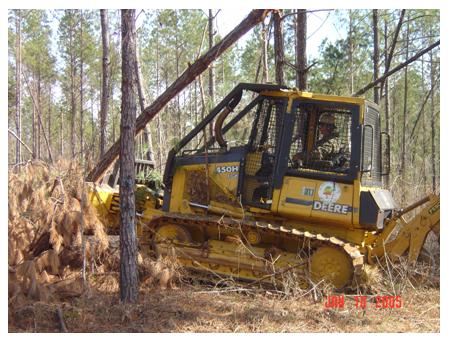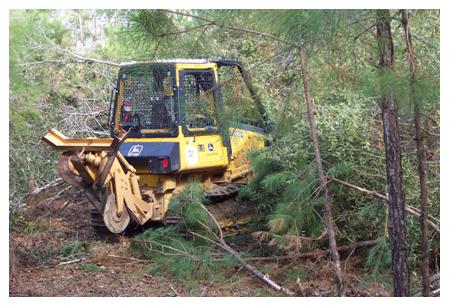|
Home |
Search the Database |
Display Index |
Contact Us |
Database Login
|
The national database of state and local wildfire hazard mitigation programs
serves as a clearinghouse of information about nonfederal policies and
programs that seek to reduce the risk of loss of life and property through
the reduction of hazardous fuels on private lands. If
you would like to submit a program to the national wildfire programs database,
please complete the following form (MS
Word).
Return to your search results or Perform a new search
|
Title: |
Alabama Wildfire Mitigation Program
|
|
Type: |
Fuelbreaks
Education
Demonstration projects
|
|
Jurisdiction: |
State
|
|
State: |
Alabama
|
|
Program Description: |
Background
The Alabama Forestry Commission (AFC) began efforts to address fire prevention in the WUI in 1988 by encouraging formation of WUI councils and requesting that the larger municipal and regional planners consider fire protection in their land use planning and development ordinances. Numerous educational programs and hazardous fuel reduction projects have been conducted in high fire risk areas with National Fire Plan funding.
Education and Outreach
The Alabama Forestry Commission takes a proactive role in informing the public about their responsibilities in fire prevention in the wildland/urban interface in order to reduce wildland fires and structural losses. The AFC has two employees dedicated to fire prevention and wildland/urban interface programs. One is based in north Alabama at Florence and one in south Alabama at Bay Minette. The AFC has held fire prevention workshops focused on firewise concepts for 300 of the agency�s employees in Clanton and Greenville, Alabama.
Publications developed and distributed as part of the State�s educational efforts include Safety Guidelines for Woodland Developers, Firewise Landscaping for Woodland Homes, and the newspaper insert, Living with Fire. Firewise education in the classroom has been facilitated using the Alabama Reader; a 12-page, single edition newspaper that discusses arson, the role of fire in the environment, and other aspects of fire awareness. The publication was distributed to teachers in 34 high-risk communities facing arson problems.
Fire Prevention Planning
Targeted fire prevention plans were prepared in the AFC�s ten hottest fire occurrence counties. General fire prevention plans were prepared for more counties with a lesser risk of wildfire. These plans lay out specific actions and timelines to accomplish a higher level of forest fire prevention. Regional fire prevention specialists and county managers will implement these plans with guidance from the fire division and regional foresters.
Fire Suppression Preparation
As part of its fire suppression program, the AFC has upgraded three helicopter water buckets and enhanced coordination with the Alabama Army National Guard flight facilities to provide water drops on wildfires in inaccessible areas and high intensity fires in interface situations. Ten additional AFC firefighters have also received training on the operation of the AFC�s three John Deere 750 dozers. These rangers will supplement the mitigation, rehabilitation and firefighting efforts in the counties most affected by hurricane Ivan. This is in addition to the AFC equipment fleet of 150 tractor plow units statewide. As part of the National Fire Plan efforts, the AFC funds and runs the Alabama Interagency Wildland Fire Academy, in which about 80 volunteer firefighters and over 500 state and federal agency personnel receive basic and advanced NWCG fire training. In a special effort, the AFC has trained over 75 paid and volunteer firemen (Gulf Shores, Bon Secour, Bayou La Batre, and City of Mobile Fire and Rescue Emergency Response Team) on Forest Fire Behavior and the Wildland/Urban Interface.
Fuels Reduction Projects
In an effort to break-up continuous areas of hazardous fuel loading on forests within the WUI, the AFC cleared a total of 2443 miles of eight to ten-foot wide firebreaks between 2002 and 2005.
In an ongoing project, the AFC and the Gulf Coast Resource Conservation and Development Council are in the process of creating a demonstration fuels mitigation project on the coast of Mobile and Baldwin Counties. By example, this project is hoped to encourage increased hazardous fuel reduction in coastal communities-at-risk.
Ground work on a Firewise demonstration project is underway in Canterbury Estates Subdivision, just north of Bay Minette, AL. The Gulf Coast RC&D; Council is leading the project which involves the establishment of a firebreak around houses and vacant lots that are adjacent to several hundred acres of forestland. This firebreak will serve as a fuelbreak and access corridor for firefighting equipment. The project also includes hazardous fuel reduction and creation of defensible space.
Hurricane Ivan�Education and Mitigation
Hurricane Ivan created even more challenges and opportunities for forest fire prevention. Every county was affected to some extent, but nine counties in particular were specifically identified to receive extraordinary mitigation attention.
The AFC brought in an out-of-state, NWCG-recognized, three-man team of Certified Fire Behavior Analysts to look at fuel types and timber damage caused by Ivan. Their task was to assess significant alterations to fuel types, look at potential fire behavior and recommend ways to deal with the changes caused by Ivan. The AFC will use this analysis to enhance prevention efforts, readiness and operations.
Another post-Ivan mitigation tool is a program to rehabilitate firebreaks and forest access roads. The AFC has implemented a pre-suppression access program to provide this service to landowners who qualify. Through this program, the AFC has reopened over 200 miles on 144 landowners in nine affected counties.
AFC fire prevention teams are also been used to accomplish door-to-door contact with residents, and to distributing fire prevention literature, such as Don't Get Burned by Ivan. This is being done at a critical time - teachable moments - when Ivan�s destruction is still evident.
In addition, a media blitz is underway in order to capture the attention of citizens and communities most affected by Hurricane Ivan. Radio, television and newspapers are frequently used to communicate AFC�s message and presented tips and stories about fire prevention. Also, the informative and colorful �Living with Fire� newspaper insert, was re-circulated in four highly impacted counties.
Contact Information
For more information, contact Louis Hyman at [email protected] or Stanley Anderson at [email protected].
|
|
Images: |
|
1. | 
|
|
|
|
2. | 
|
|
|
|
|



